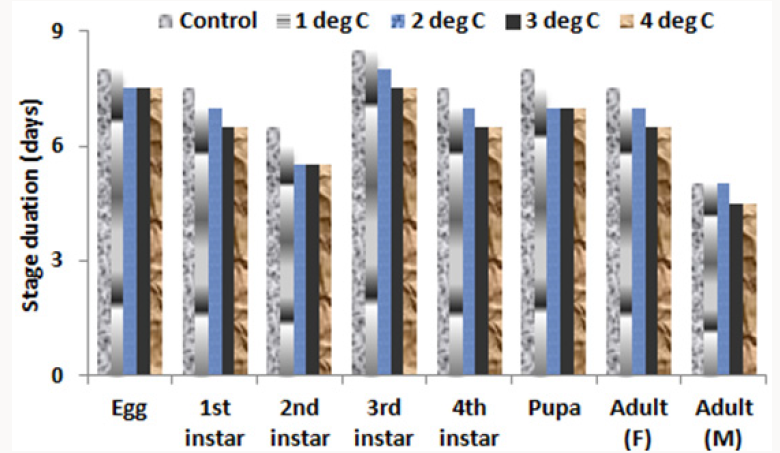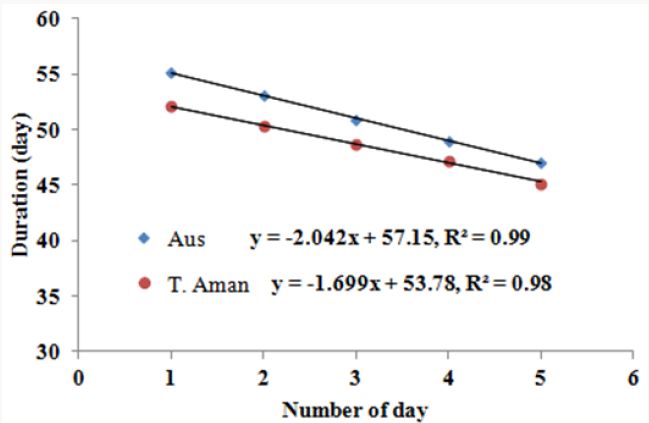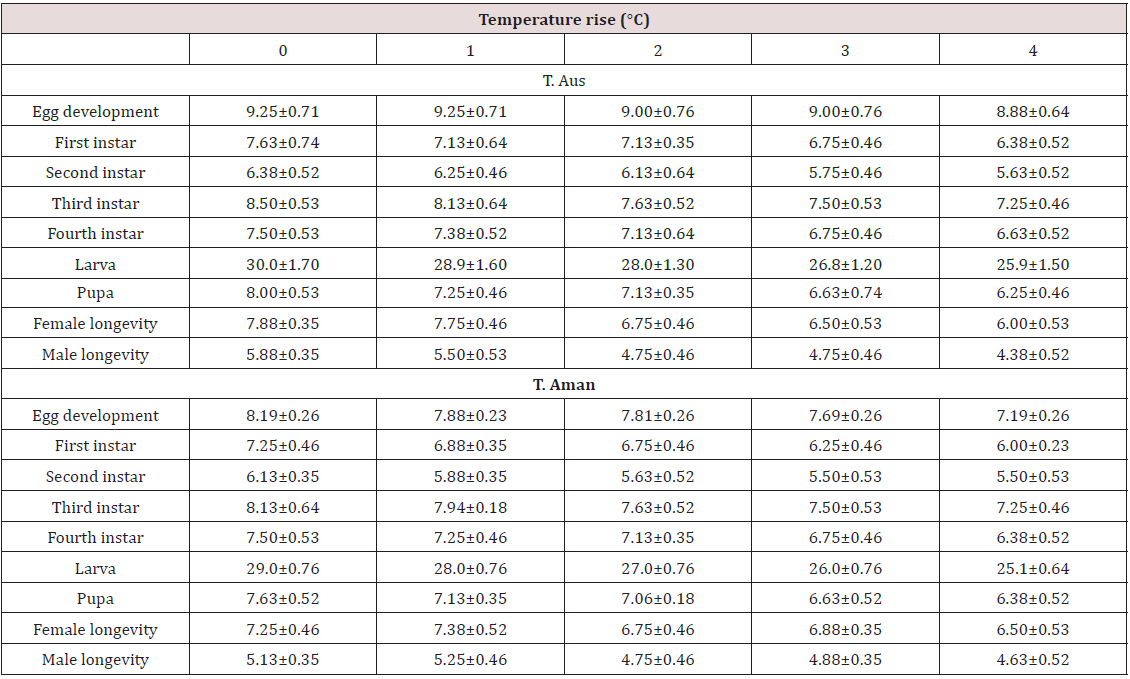Lupine Publishers | Agriculture Open Access Journal



For more Agriculture Open Access Journal articles Please Click
A simple model was developed using Fortran Simulation Translator to
study the influence of increased temperature on duration of
various life cycle phases of yellow stem borer (YSB) in Bangladesh
environment. Model was primarily based on Growing Degree
Day concept, by also including cardinal temperatures sensitive for
specific growing stages of YSB. After successful calibration and
validation of the model, it was taken for climate change (only
temperature rise considered in the present study) impact analysis
on the growing cycle of YSB. Temperature increase values of 1, 2, 3 and 4
oC were considered and compared with the Control
(no temperature rise), by using historic weather of representative
locations in eight Divisions of Bangladesh. Differential spatial
response in the life cycle of YSB under various temperature rise
treatments was noticed, and in general the growing cycle hastened
with the rising temperature. The life cycle of YSB is likely to be
reduced by about 2 days for every degree celcius rise in temperature,
while averaged over locations. This means that there will be 2.0-2.5
additional generations of YSB in pre-monsoon season about
2.9-3.2 in wet season of Bangladesh. There is a need to include the
phenology module developed in subsequent design of population
dynamics model for YSB.
Keywords: Model; Growing degree days; Yellow stem borer; Life cycle assessment; Temperature rise
Introduction
Yellow stem borer (YSB) is the most destructive and widely
distributed insect-pest of rice. It causes dead heart or white head,
depending on infestation time and significantly reduces rice yields
by 5-10% and even up to 60% under localized outbreak conditions
[1]. It can grow in places having temperature >12 oC and annual
rainfall around 1000mm. Generally, temperature and high relative
humidity (RH) in the evening favors stem borer growth and
development [2]. The female moth oviposits from 1900 to 2200hr
in summer, 1800 to 2000 hr in spring and autumn, and deposits one
egg mass in a night and up to five nights after emergence. Optimum
temperature is 29 oC having 90% RH for maximum number of eggs
deposition. Optimum temperature for egg hatching is 24-29 oC with
90-100% RH. Larvae die at 35 oC and hatching is severely reduced
when RH goes to below 70% [1]. Larvae can�t molt at 12 oC or
below and they die. The last instar larvae can survive unfavorable
growth condition as diapauses, which is broken by rainfall or
flooding. In multiple rice cropping, no diapauses takes place. The
pupal period can last for 9-12 days and the threshold temperature
for its development is 15-16oC.
The number of generations in a year depends on temperature,
rainfall and the availability of host [1]. The occurrence of the pest
is generally the highest in wet season [3]. Since there are many
stem borer species, the average life cycle of rice stem borers
varies from 42-83 days [4], depending on growing conditions. This
implies that heterogeneous population can be found in the same
rice field. Manikandan [5] also reported that development time by
different phases of YSB decreases with higher temperature and
thus increased population likely in future at early growth stages of
rice crop. However, no such data is available in Bangladesh.
Keeping the acute problem of YSB in Bangladesh, the present study
was undertaken to develop a simple phenology-based) model to
assess the life cycle of YSB in two major growing seasons of rice and
subsequent taking it to evaluate the effect of rising temperature on
growth cycle of rice yellow stem borer in representative locations
of eight Divisions of Bangladesh.
Materials and Methods
Model description
Model for assessing the phenology of yellow stem borer was
written in Fortran Simulation Translator and the compiler used is
FSTWin 4.12 [6]. This model will subsequently be used to develop
population dynamics model for YSB in rice-based cropping systems
prevalent in Bangladesh. Growing degree days (GDD) concept was
used for this purpose, with base temperature assumed as 15 degree
Celsius, below which growth and development activity in the life
cycle of YSB does not take place. Each day, average temperature
(mean of maximum and minimum temperatures) minus the base
temperature is integrated over the growing cycle, and subsequently
the development stage is achieved when critical value for attainment
of a particular stage is crossed.
In the INITIAL phase, the GDD is taken as zero, which is read
one time during running of the model
INCON GDDI, initial value of GDD = 0.
In the DYNAMIC phase, the program is executed daily till the
FINISH Condition is achieved.
DAS, days after start of simulation = INTGRL (ZERO, RDAS)
PARAM RDAS, day increment rate = 1.
The development stage can be expressed in development stage
(0-1), but in the present study not used for development stage
identification, which we will use in further design of population
dynamics model in coming times.
DVS, development stage = INTGRL (ZERO, DVR)
DVR, rate of development stage increase, Arbitrary Function
Generator- a well defined FST function=AFGEN (DVRT, DAVTMP)
Since the age of male is relatively lower than the age of the
female, so the computation is done separately as indicated below:
*FOR FEMALE
FUNCTION DVRT = -10.,0., 0.,0.,15.,0.,35.,0.03325,40.,0.0415
*FOR MALE
FUNCTION DVRT = -10.,0., 0.,0.,15.,0.,35.,0.0342,40.,0.0426
Base temperature below which the activities do not take place,
degree celcius, is given as under:
PARAM TBASE=15.
Reading of weather data, on daily time step, is read through
external file, as per well defined format for FST compiler, as given
below:
WEATHER WTRDIR='c:\WEATHER\';CNTR='
GAZI';ISTN=1;IYEAR=
200
Where, various climatic elements are used as below:
RDD is solar radiation in J/m2/day
DTR = RDD
TMMX is daily maximum temperature; COTEMP is the climate
change, temperature rise switch for evaluating the impact of
temperature rise on the phenological development of the life cycle
of YSB. TMMN is daily minimum temperature.
DTMAX = TMMX+COTEMP
DTMIN = TMMN+COTEMP
DAVTMP, average temperature (derived parameter) = 0.5*
(DTMAX + DTMIN)
DDTMP, day time average temperature, derived parameter =
DTMAX - 0.25* (DTMAX-DTMIN)
COTEMP is temperature rise/fall switch
PARAM COTEMP = 0.
DTEFF, effective temperature after deducting the base
temperature = AMAX1(0., DAVTMP-TBASE)
SVP, is saturated vapor pressure in mbar, calculated from
temperature (derived value)
SVP = 6.11*EXP (17.4*DAVTMP/(DAVTMP+239.1))/10.
VP is Actual vapor Pressure, mbar, an input for running of the
modelAVP = VP
AVP = VP
RH is relative humidity, expressed in %, derived from the vapor
pressure as below:
RH = AVP/SVP*100.
In the present study, only temperature and relative humidity
effects are undertaken for computation of the phonological stages of
the life cycle of YSB, although we have described the other climatic
elements as part of the FST compiler, but the other parameters will
also be used in deriving the population dynamics model, which we
will take up in later course of time.
Since the development stages of YSB are influenced by relative
humidity also, so we have to introduce the correction factor for
including the effect of humidity, as below:
DAVTMPCF, RH induced temperature correction = DAVTMP*CFRH
TMPEFF=DAVTMPCF-TBASE
CFRH is the Correction Factor for relative humidity for judging
temperature is computed as below: i.e. during hatching (CFRHH)
and larva formation (CFRHL) stages, computed as below:
CFRH, correction factor for RH=INSW (GDD-EGHATCH, CFRHH,
DUM11)
DUM11=INSW (GDD-979.9,CFRHL,1.)
Where INSW is FST Function, if GDD<979.9, then CFRHHD is
taken and otherwise DUM11
CFRHH=AFGEN (CFRHHT, RH)
CFRHL=AFGEN (CFRHLT, RH)
FUNCTION CFRHHT=50.,0.9,60.,0.9,75.,1.,90.,1.1
FUNCTION CFRHLT=50.,0.95,60.,0.95,75.,1.,90.,1.05
WDS, wind speed in m/sec = WN
RRAIN, daily rainfall in mm = RAIN
TRAIN, total rainfall in mm = INTGRL (ZERO, RRAIN)
GDD is growing degree days, expressed in degree Celsius-days,
is calculated as below:
GDD=INTGRL (GDDI, TMPEFF)
On the basis of literature search from the published literature,
the growing degree days for various stages were computed and
used in development of the model, and is described as below:
EGHATCH is the thermal degree days requirement for egg
hatch, is as below:
PARAM EGHATCH=119.7
INSTAR1 is thermal degree days for end of first instar 1 stage
PARAM INSTAR1=224.9
INSTAR2 is thermal degree days for end of second instar stage
PARAM INSTAR2=317.0
INSTAR3 is thermal degree days for end of third instar stage
PARAM INSTAR3=438.7
INSTAR4 is thermal degree days for end of fourth instar (larva)
stage
PARAM INSTAR4=550.3
PUPA, is thermal degree days for end of pupa stage
PARAM PUPA=662.452
ADULT LONGIVITY is thermal degree days for end of adult
longevity, which is different for male/female, For Male=741.484
and Female=773.538, depending upon the defined parameter SEX
ADULT=INSW (SEX-1.05, FEMALE, MALE)
SEX=1. For female and 2. For male
PARAM SEX=2.
PARAM MALE, growing degree days for male = 741.484
PARAM FEMALE, growing degree day for female = 773.538
Critical temperature above which the egg hatching stops is
defined as below:
DEATH=REAAND (EGHATCH-GDD, DTMAX-40.)
HATMI, minimum temperature below which the Hatching
stops, is defined as below
PARAM HATMIN=15.
DEATH1=REAAND (EGHATCH-GDD, HATMIN-DTMIN)
LATMIN, minimum temperature below which larval growing
stages stop, and is given as under:
PARAM LATMIN=12.
DEATH2=INSW (GDD-EGHATCH,0.,REAAND(INSTAR4-GDD,LATMIN-
DTMIN))
REAAND is FST Function, which will be 1 when both the
variables within parenthesis are greater than zero; otherwise the
value will be 0.
Duration of various stages is computed as below:
EGHATCHD is egg hatch duration, in days and computed as
below:
EGHATCHD=INTGRL (ZERO, DUM1)
DUM1=INSW (EGHATCH-GDD,0.,1.)
INSTAR1D is INSTAR1 Termination Day
INSTAR1D=INTGRL (ZERO, DUM2)
DUM2=INSW (INSTAR1-GDD, 0.,1.)
INSTAR2D is INSTAR2 Termination Day
INSTAR2D=INTGRL (ZERO, DUM3)
DUM3=INSW (INSTAR2-GDD, 0.,1.)
INSTAR3D is INSTAR3 Termination Day
INSTAR3D=INTGRL (ZERO, DUM4)
DUM4=INSW (INSTAR3-GDD, 0.,1.)
INSTAR4D is INSTAR4 Termination Day
INSTAR4D=INTGRL (ZERO, DUM5)
DUM5=INSW (INSTAR4-GDD, 0.,1.)
PUPAD is PUPA Stage Termination Day
PUPAD=INTGRL (ZERO, DUM6)
DUM6=INSW (PUPA-GDD,0.,1.)
ADULTD is Adult Life End Day
ADULTD=INTGRL (ZERO, DUM7)
DUM7=INSW (ADULT-GDD, 0.,1.)
Stop of Run Condition is as under:
FINISH DEATH > 0.95
FINISH GDD> 775.
Integration conditions for running of the program are as under:
TIMER STTIME = 360., FINTIM = 600., DELT = 1., PRDEL = 1.
TRANSLATION_GENERAL DRIVER='EUDRIV'
PRINT DAY, DOY, DVS, RH, AVP, SVP, WDS, TRAIN, GDD, DAVTMP,
DAVTMPCF, ADULTD, PUPAD
In the TERMINAL stage, the final values at the stop of model run
can be written in an external file:
CALL SUBWRI (TIME, COTEMP, EGHATCHD, INSTAR1D,
INSTAR2D, INSTAR3D, INSTAR4D, PUPAD, ADULTD)
END
Reruns options for evaluating the impact of temperature rise
on the development stages of the YSB can be run through this given
below procedure:
PARAM COTEMP=1.
END
PARAM COTEMP=2.
END
STOP
Experimental
Growing degree days for attainment of various growing stages
in the life cycle of YSB were collated from the published literature
in this region. The model was calibrated with 2003 weather data
of Bhola district of Bangladesh against the findings of Manikandan
[5] at 30 oC. After model calibration, it was subsequently taken
to climate change window, temperature rise only considered in
the present study. Eight divisions (Dhaka, Mymensingh, Rajshahi,
Rangpur, Sylhet, Khulna, Chittagong and Barisal) of Bangladesh
were taken and one representative location was chosen from
each division and historic weather data of 35 years were taken
for running of the model and the duration of each development
stage was computed and compared amongst temperature rising
conditions. In the present study, daily temperature rise from 1-4 oC
were considered for two growing seasons, .com rice season i.e. premonsoon
(April to June) and Aman Rice season i.e. Monsoon (late
June to November) of Bangladesh.
Figure 1: Days required for completion of growth stages of rice yellow stem borer with increased temperature by 1, 2, 3 and 4
degree celcius in the growing environment of Bhola, Bangladesh.

Results and Discussion
During the test period, minimum temperature averaged
26�0.115 and maximum temperature around 31�0.32, with the
average temperature around 30 oC, which was used for calibration
and validation of the model, and the model performed satisfactorily
well, through nice agreement between observed and simulated results (Table 1). Depending on growth stages, the percent
deviations were within the limit of model errors. The application
of model for specific years of Bhola district showed that the growth
stages of rice yellow stem borer (YSB) were decreasing (Figure 1)
by about 1.76 days per degree rise in temperature (Y=1.7X+54.6;
R2=0.932). This indicated that YSB is likely to infest more rice
plants in future under increased temperature conditions. Ramya
[7] also reported that YSB would likely to develop faster, oviposit
early and thus enhanced population build up than expected. There
are reports that temperature increase by 2oC may cause 1-5 times
additional life cycles of insects in a season [8].
Results, from represented locations in the eight Divisions of
Bangladesh, showed that growth stage of YSB varied depending
on season (Table 2). In .com pre-monsoon season, life cycle of YSB
would likely to be completed within 47-53 days, depending on
locations and temperature rise from 1-4 degree celcius. Similarly
in Aman wet season, it would about 45-50 days for temperature
rice from 1-4 degree celcius. However, under the Control (no
temperature rise) condition, it requires around 52 days for T. Aman
and 55 days for .com. Our findings indicate that growth cycle of YSB
is likely to decrease by 2.04 days per degree rise in temperature
in the .com season and 1.70 days in T. Aman season (Figure 2).
Similar results were reported by Manikandan [5]. Generally, insect
population build up depends on favorable weather conditions and
availability of host. So, there will be ups and downs in the peak
build ups in a cropping season [9]. Although model data needs to
be cautiously adopted, it clearly showed that with climate change
impact the infestation of YSB would be increased, which might be
cause of yield reduction, if not proper management is taken at the
right time [10].
Figure 2: Total life cycle duration of yellow stem borer as influenced by temperature rise during .com and T. Aman, season
(averaged over eight Divisions of Bangladesh).

Table 2: Developmental phases (in days) of rice yellow stem borer as influenced by temperature rise in different growing seasons.

Conclusion
Yellow stem borer of rice crop is a major concern in Bangladesh.
Dead hearts and white heads caused by YSB significantly reduce
growth and yield of rice crops, especially in .com (Pre-monsoon)
and T. Aman (Monsoon) seasons. There is a need to understand
the phenology i.e. life cycle assessment and population dynamics
of YSB in the growing environments of Bangladesh. In the present
study, a simple model, as written in Fortran Simulation Translator
(FST), was developed to assess the life cycle of YSB. The model
was primarily based on growing degree day�s concept, by also
considering cardinal temperatures for specific phenological/
development growth stages of YSB. The model was successfully
validated with the growing environment of Bhola district of
Bangladesh. Subsequently, the model was taken to assess the
impact of rise in temperature on life cycle of YSB in representative
locations of eight Divisions of Bangladesh. The response was spatiotemporally
and seasonally variable. The life cycle hastened with the
rise in temperature by 1-4 degree celcius. We, in near future, plan to
develop a population dynamics model for YSB and to subsequently
link it with the rice growth model to evaluate the yield reductions
associated with YSB infestations
For more Lupine Publishers Open Access Journals Please visit our website: https://lupinepublishersgroup.com/
To Know more Open Access Publishers Click on Lupine Publishers
Follow on Linkedin : https://www.linkedin.com/company/lupinepublisher
Follow on Twitter : https://twitter.com/lupine_online

No comments:
Post a Comment